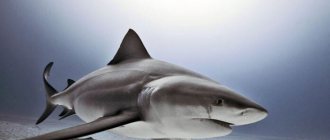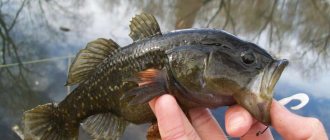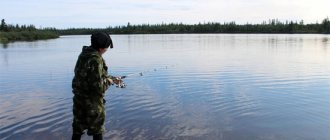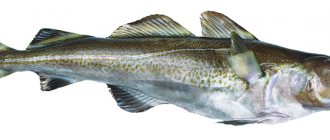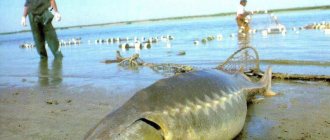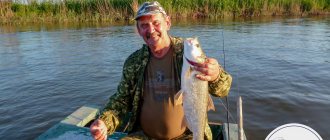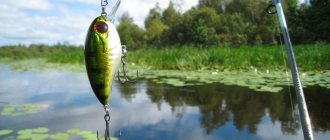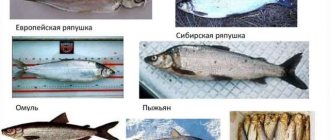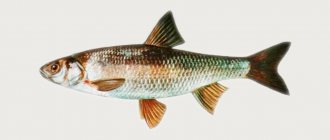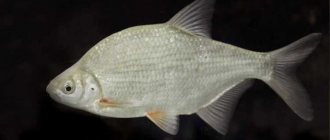Appearance and characteristics
Asp is a fish of the order Cyprinidae, the carp family. It is distinguished by the presence of many bones. The asp has a massive body, at the same time thick, shortened, and spindle-shaped. The back is wide.
The asp has a grayish color, uneven, varying from the back to the belly: the back is dark, with a gray-blue tint, the sides are silver-blue, and the belly is white. The body has large silvery scales. The front and lower fins are distinguished by a gray tint, darkening at the tips. The dorsal fin is thin, long, and sharp.
The fish has a powerful tail, the lower half of which is slightly longer than the upper. A distinctive feature is an elongated head, a large mouth, and a massive lower jaw.
These external features and lifestyle became the reason not only for the official name of the fish, but also for the appearance of other everyday names:
- Horse (mare). The fish can jump high.
- Shersper. From the obsolete verb “to bristle”, which in translation is to bristle, to be lively.
- Grab. For agility and reaction speed.
- Whiteness (whiteness). For color features: silver-grayish sides and white belly.
- Sherikh, shilishper, cherich, shereshper, zherich. Regional, distorted forms of the original name.
In the modern world, the asp is called a “river corsair”, because the fish likes the flow. Fish are found only in clean rivers rich in oxygen.
Habitat and distribution
Asps are found in natural reservoirs, significantly limited to small rivers and small lakes. For full life, fish need spacious and deep water areas, where there is clean and flowing, oxygen-rich water, as well as a very impressive food supply.
Under natural conditions, such fish inhabit systems represented by large rivers, large lakes, and reservoirs of the South, Baltic and North seas of Russia.
The habitat of the asp is small, including some territories covering Eastern Europe and a significant part of Western Europe. The fish is found in parts of the Eurasian continent - between the Ural and Rhine rivers, in Central Asia: parts of Kazakhstan or the basins of the Caspian and Aral seas. There are a lot of asps on the Volga.
A small number of asp individuals are observed in the waters of Lake Balkhash, where commercial fish appeared artificially.
Fishing for asp, How to catch asp fish
The asp fish does not like unnecessary noise. When catching asp, you need to be careful and be quiet on the pond. The spoon should be cast as far as possible. Catching an asp is an art and requires good skill and precision casting. Those fishermen who catch it can consider themselves good fishermen. Pointless casts across a pond will not lead to good results; you need to throw the bait exactly into the fish’s habitat.
Castmaster is the best lure for asp.
Spinning fishing is very exciting. To catch asp, you need to take a rigid two-handed rod. It is better suited for long casts with heavy bait. With such a rod it will be easier to hook. We take a large reel so that we can reel in 100 meters of fishing line. Take a fishing line with a diameter of 0.4 mm. Lures are in the form of small fish, you don’t need to take big ones, the fish bite on them reluctantly. You also need to choose bait based on the fishing location, current strength and depth.
In summer, bait should be placed in the upper layers of the reservoir. To do this, you need to take heavy baits without weight. They do not create unnecessary noise that can scare the fish, and they are easier to fish at the same depth level, no deeper than 20 cm from the surface. And they are great for long casting. If you fish across or against the current, then a “triple-edged”, “piggy”, “success” spinner no heavier than 30 grams is suitable. And if you make casts downstream or from bridges, then you need to take a spinner or Devon.
An asp caught with a castmaster.
You need to cast in such a way that there are as few splashes of water as possible. And as I already said, not far from the fish’s habitat, no more than 5 meters from its location. Just before the bait hits the water, you need to brake with the reel and slightly raise the top of the rod. You need to start reeling right away, the asp reacts with a splash and immediately goes on the attack. the asp fish will catch up with even a fast-moving bait.
On rapids and riffles, fishing should begin from the upper sections and gradually go downstream, gradually making long casts from the shore.
The best results are obtained by fishing in a wade, when entering waist-deep water. When biting, the asp desperately resists, making several throws and blows. But then he calms down and allows himself to be pulled out calmly.
Asp fish can also be caught using live bait in the retrieve. You need to take a float such that the live bait does not drown it, let it go far away from you. The live bait is placed on two separate hooks, and a rod with a reel and rings is taken. You need to be above the fish site. The live bait should be horizontal, the float should not be bright, and preferably without a load. When there is a bite, the line will begin to tighten; if there is no bite, then you need to re-show the live bait in the same place.
Tips for fisherman: How to fry asp caviar in a frying pan - Choosing the best
An asp caught with a vibrating tail.
The asp can be provoked to bite with bait. When feeding, small fish will begin to gather, which the asp will begin to hunt. A single asp can be caught using wobblers. They are set adrift in the area where the asp is fighting; you can play with the wobbler in short jerks. In general, for successful fishing you need to carefully introduce yourself to the reservoir, make long casts, and be able to guide the bait along the top surface of the reservoir.
When fly fishing you need to use insects as they fly out. At this time, you can’t find better bait. We use the same flies as we use to catch chub, and the fishing technique is the same. Only the asp prefers “dry” flies of light and bright shades. Fly fishing should be done shallowly or with the bait slightly submerged. When fly fishing, you also need to hide from the fish as best as possible and be unnoticed.
In the autumn, the asp fish gradually moves to quiet places with greater depth. In autumn, the asp is less afraid of passing boats. At this time, baits should be placed closer to the bottom. The technique is the same as when catching all predators. When fishing on the track, take the same baits as when fishing with a spinning rod.
In winter, asp fish are caught mainly in the southern regions. After winter, the asp has little strength and does not chase fish. At this time, it can be caught with a worm, maggot, or bloodworm. After a couple of weeks, he regains his strength and begins to actively hunt.
The largest asp was caught in Belarus weighing 12 kg. With a length of 80 cm. He was 17 years old.
Happy fishing when catching asp fish!
Asp is a predator fish.
This fish is found mainly in the basins of the Baltic, Northern, Black, Caspian and Aral seas.
As for the last two, the asp is represented by special subspecies. The closest relative of the asp, or as biologists call it, the second species of the genus, lives in the Tigris River (mainly flows through Turkey and Iraq).
The common asp is found in rivers on the lowlands and sometimes in lakes. If the river bed was used to create man-made reservoirs, the asp is preserved there too. To the south, in the seas, the asp leads a so-called semi-anadromous lifestyle. That is, it mainly lives in the estuarine areas of the sea, and for spawning it rises upstream of rivers flowing into the sea.
Asp (Aspius aspius).
The asp is a predatory fish; in rivers it mainly feeds on small fish, mainly bleak. Slightly less often, minnows and young specimens of other fish species become its prey.
Asp connoisseurs and lovers have come up with many more names for this fish. Such, for example, as “horse”, “messenger”, “grab”. The fact is that, unlike other predatory fish, the asp does not lie in wait for prey. He will attack quickly and powerfully, like lightning. Crashing into a school of small fish, it stuns it with a blow of its tail, then jumps out of the water and falls back again. He repeats this maneuver several times, then turns downstream and catches the stunned fish.
Asp is a predator fish.
This method of hunting is called “battle” because it causes such a noise, as if the water surface had indeed become a battlefield. It is very interesting to watch this process; the asp’s fast and strong movements, as well as his hunting ingenuity, cannot but arouse respect and admiration for his abilities. By the way, when an asp jumps out of the water, it straightens the hard rays of its fins, for which it received another name - “sheresper”.
The asp hunts near rifts and sandbanks - in a word, where a lot of its potential prey, small fish, gather.
The asp's method of hunting is called "fighting", and it occurs at lightning speed.
A small asp was caught on a hook.
Asp is widely distributed in the waters of Central Europe, namely in the basins belonging to the Black, Baltic and North Seas. This fish is one of the most common in reservoirs located in the basins of the Azov, Black and Caspian (its northern part) seas. The red-lipped asp is found in the waters of the southern and middle Caspian Sea, and in the Aral Sea there is a separate subspecies. You can meet this representative of the ichthyofauna in the following countries:
Types of asp and its features
The fish grows very quickly, gaining impressive sizes. When fishing, fishermen can boast of catch weighing 2-2.5 kilograms with a body length of 60 centimeters. Often there are fish weighing 4-5 kilograms and a length of 75-80 centimeters. But these indicators are far from the maximum. Fishermen managed to catch giant fish measuring 120 centimeters long and weighing 12 kilograms. Among the carp family, asp is a large and aggressive fish.
The average monthly water temperature directly affects not only life expectancy, but also the size of the fish. The fish is a long-liver, because the exact age has not yet been established, but it is believed that some individuals can live up to 15 years. The fish owes its vitality to its natural cowardice and reaction speed. If an individual sees an approaching shadow near the shore, it will immediately hide in the depths.
There are several varieties of asp, which are described below.
Amur flathead
The fish prefers to live at the bottom of the river. The asp has an elongated body, a low and at the same time elongated head, and a flattened forehead. A distinctive feature is the scarlet fins, due to which the Amur asp is also called the rudd. Lives in the Amur River basin: Onon, Ussuri, Shilka, Buir-Nur, Khanka, Sungari. The fish lives up to 20 years, grows up to 80 centimeters in length, gaining a weight of 2-4 kilograms.
Western Asian
This is a small fish, weighing 1.5-1.6 kilograms with a body length of 50-55 centimeters. They are distinguished by high fertility, but still the asp population is significantly reduced. The reason for this is the constant discharge of industrial waste and wastewater into the river.
Aral
The Aral asp lives in salt and fresh water bodies of Central Asia. Lives up to 9 years. It is distinguished by light smoky fins and a more squat body in comparison with the common asp. Reaches a weight of 5.5-6 kilograms with a height of 65-70 centimeters. The main feature of the Aral sheresper is the purple color of the mouth and all fins.
Pirate from the Fish World
Many fishermen call the asp a river pirate, whitefish or horse, and this type of fish has fully deserved each of these nicknames.
Asp pursues its prey like desperate filibusters of bygone centuries, not giving it the opportunity to hide from a swift attack.
The asp received the nickname “horse” for a very extravagant way of attacking the victim: before the attack, the asp fish jumps high above the surface of the water and hits the surface of the reservoir with its tail, which often stuns its victim.
Well, the etymology of the nickname “whiteness” is extremely simple - the asp received this nickname for its white color.
«>
«>
«>
«>
«>
«>
«>
«>
«>
Residential river populations are not large in size. The passage form is larger, reaching a length of 80 cm and a weight of 4-5 kg. However, the catches are dominated by individuals 60 cm long and weighing 2.5 kg. The age limit is 9-10 years in northern populations and 5-6 years in southern populations.
Latin name:
Aspius aspius
Other names:
sheresper
Family:
Cyprinidae
Genus:
Asp
Type:
freshwater
Lifestyle:
pelagic
Diet type:
carnivorous
Habitat:
Black Sea basin, Baltic Sea basin, Caspian Sea basin, Aral Sea basin
Tips for fisherman: Spinning rod for catching asp from the shore - Choosing the best
In the lateral line 63- 78 scales. Gill rakers are few (7-11) and short. The pharyngeal teeth are high, strong, hook-shaped, smooth, double-rowed, their formula is usually 3.5-5.3, but sometimes 2.5-5.3 or 3.5-5.2. Vertebrae 47-52.
Residential river populations are not large in size. The passage form is larger, reaching a length of 80 cm and a weight of 4-5 kg. However, the catches are dominated by individuals 60 cm long and weighing 2.5 kg. The age limit is 9-10 years in northern populations and 5-6 years in southern populations.
Habitat and behavioral characteristics:
Pelagic predator, sticks to riverbed areas and reservoir reaches in the upper and middle water horizons. It leads a solitary lifestyle and forms small flocks only during the spawning period in the spring and during the period of hibernation in the fall.
But even with teeth, predators have enough problems with catching prey. It is clear, therefore, that a predator that has no teeth finds itself in a very difficult situation. Both to grab and to hold - both are a problem for him. This is just about the asp.
He is a horse, grip, whiteness, sheresper
The asp is one of those fish that needs no introduction. Everyone knows about him, everyone wants to catch him, but few can boast of this.
Fortunately, not being inclined to gather in large permanent aggregations, it is not an important commercial target and for this reason has remained aloof from the main road of ichthyological research. The biology and lifestyle of the asp are known only in the most general terms. In this sense, it cannot be compared with the same bream, pike perch and other commercial species, which ichthyologists have actively studied and are studying precisely in connection with the needs of fishing and fisheries in general.
It is all the more interesting to collect, if possible, all available information and try to paint a general portrait of this wonderful fish.
SYSTEMATIC POSITION
Belongs to the carp family, includes a single species: Aspius aspius (Linnaeus, 1758) - common asp
In Europe and on Russian territory, there are 2 subspecies: the common asp and the red-lipped asp (in the rivers of the Middle and Southern Caspian). The Aral asp subspecies inhabits the Aral Sea basin.
SPREADING
The red-lipped asp is found in the Kura, Araks and rivers of the southern part of the Caspian Sea (Turkey, Iran). The common asp was unintentionally acclimatized in Balkhash and the river. Or (Kazakhstan).
The Aral asp lived in the Aral Sea, where it disappeared as a result of the environmental crisis. Found in lowland reservoirs of the Amu Darya and Syr Darya basins. Through irrigation canals it entered the Kashkadarya and Zarafshan basins.
MAXIMUM DIMENSIONS
Typical predator. The diet is based on small schooling pelagic fish: bleak, verkhovka, juvenile chub, roach, sabrefish. It also eats bottom-dwelling species – gudgeon and even ruffe. Non-fish food (insects and their larvae, crustaceans, worms, vegetation) plays a minor role in the diet.
It switches to predation already at a length of 5-9 cm (in August-September). In the Volga delta, asp fry consume juvenile roach, silver bream, bleak, sabrefish, and carp; in the Neman - juvenile smelt, roach, and stickleback.
LIFESTYLE
Spawning takes place in mid-April - early May at a water temperature of 5 - 10 °C. It lays eggs on rocky rifts or sand spits, and less often (in the lower reaches of rivers) on shallows. In floodplain reservoirs it spawns in flowing areas, in reservoirs - in riverbed and coastal areas. In large rivers, as well as in lakes and reservoirs, it can enter small tributaries to spawn. Spawning is one-time, friendly, and under favorable conditions lasts about 2 weeks.
The asp, which lives in estuaries and estuarine areas of large rivers (Volga, Dnieper, Dniester, Don), makes spawning migrations upstream. Fish from the middle and upper sections of the river are sedentary and do not make long migrations. Before spawning, it feeds actively, sometimes feeding continues during spawning.
Having spawned, the asp rolls down either into the main channel (if it spawned in tributaries) or into the lower reaches of the river (semi-anadromous estuary and estuary asps). As a rule, it begins to feed 2-3 weeks after spawning, after the water has subsided, in early to mid-June.
In autumn, with cooling and clearing of the water, the asp spends more time at medium depths and near the bottom, hunting less often in the current.
During the winter, the asp lies down in pits. Estuary and pre-estuarine populations in large rivers perform wintering migrations upstream for this purpose. Often the autumn migration of the semi-anadromous asp is more widespread than the spring spawning migration.
HUNTING TACTICS
The “profession” of a predator for a fish without teeth on its jaws is fraught with certain difficulties. But the asp is clearly not afraid of difficulties, but, it seems, on the contrary: he is not just a predator, but a predator that specializes in the most difficult object - schooling fish.
It must be said that the asp also uses this twilight strategy. But still, his “calling card” is hunting in broad daylight, when the victims are in optimal visibility conditions, stay in a dense pack and are able to notice danger from afar. It is clear that the asp does not do this out of love for difficulties. For him, this is a way out of competition with other fish-eating predators. Hunting for schooling fish is an ecological niche in which neither pike, nor pike perch, nor perch can compete with asp.
But the main question is different: how does an asp with its toothless mouth manage to catch prey?
Tips for fisherman: Tackle for asp with fly and castmaster - Choosing the best
WITH AND WITHOUT TEETH
Everyone knows what asp fighting is. Few things are as impressive as the characteristic sharp and sonorous blows of this predator in the early morning, or, conversely, in the deep twilight somewhere in the shallows right next to the shore. What is the meaning of this, sometimes seemingly excessive, outburst of fish energy?
But even with teeth, predators have enough problems with catching prey. It is clear, therefore, that a predator that has no teeth finds itself in a very difficult situation. Both to grab and to hold - both are a problem for him. This is just about the asp.
The asp, like other carp fish, due to the quirks of natural selection, turned out to be completely devoid of teeth. There isn’t even any small brush on the jaws. Obviously, in such a situation, in order for the asp to feed successfully, it is necessary to use some special technique. Moreover, he often feeds on such a fast and nimble fish as bleak (by the way, even the pike with its “rate of fire” and menacing mouth does not like it for its nimbleness).
But first, a few words about how fish that live in water are fundamentally different from us who live on land.
WATCH OR LISTEN?
On land, the most informative, fast and long-range source of information about the surrounding world is light. That is why for most land animals the main tool for exploring this world and orienting oneself in what is happening around them is vision.
We don’t have anything like this, so we can’t even imagine how fish perceive the world around them. We are used to seeing it, they are used to “hearing” (in quotes, because we probably hear differently than they do).
SECRET WEAPON
The asp knows the answer to this question. Asp, as stated, prefers small schooling fish as prey. And at first glance, this is doubly surprising - not only does it have no teeth, but it also chooses the most difficult object to hunt. Moreover, it hunts successfully even in bright daylight, when flocking, as a means of protection, works most effectively. How does he achieve this?
Of course, not everything is so clear with asp fighting. The asp does not always hunt in exactly the manner described above. After all, he is caught not during the “fight”, and quite often he takes the bait at a high speed of retrieval (that is, there can be no talk of any “stunning”). In addition, it is also necessary to explain why the asp itself does not “stall” from the “explosion” it produces. There are other questions. We will wait for discoveries in this area, not only from ichthyologists, but also from spinners.
The fish becomes sexually mature at four years of age. It spawns in April–May. Caspian and Aral asp rise to spawn in rivers. They lay eggs on rocky and sandy-silty soil, in fast currents. Fertility is 70 – 360 thousand eggs. asp.
Lifestyle
Asp is a fish of lowland rivers, preferring bodies of water with a current and a width of 100 meters. Reservoirs without a current are not interesting to fish, although they sometimes get caught in them. The asp is considered a predatory chaser fish, capable of plying its routes without interruption in search of food. When the asp finds a fish, he crushes it with his tail, and then swallows it. Usually, in search of food, the asp goes beyond the islands, to the riverbed areas of the reservoir, to riffles, to the mouths of flowing rivers, to large currents far from the shore.
In the first year of life, small individuals keep in packs, then they split up and go hunting alone.
What does the asp feed on?
According to the type of feeding, asps belong to the category of pelagic ichthyophages, which adhere to the upper or middle layers in the reservoir, as evidenced by the structure of the mouth and the appearance of the fish’s body. Young asps feed exclusively on worms, insects, small crustaceans and some other small invertebrates.
After the fish reaches 30-40 centimeters in length, it turns into a predator and begins to actively eat the fry of any other fish species, preferring small bream and roach. But still, some part of the diet of a growing asp still consists of worms and insects.
Due to the fact that the fish is indiscriminate, it feeds on any similar species, including weed species: bleak, ide, minnows, and even pike perch. They are prone to chasing large fish, the size of which will fit in the mouth of an asp. Often the predator grabs prey 14-15 centimeters long.
Asps are fish that chase prey rather than wait for it in ambush. In inclement weather, during heavy rains and strong winds, predators try to go deeper, sometimes rising closer to the surface to catch various small insects or beetles that actively fall into the water from vegetation hanging over the waters of the reservoir.
Spawning
Asps grow very quickly, thanks to active metabolic processes and unpretentiousness in their diet. Already by the first year of life, the body length of the average individual is about 28 centimeters with a weight of 200 grams or more.
The fish reaches sexual maturity around the third year of life, when the average body weight of the asp reaches about 1.5 kilograms. The beginning of spawning directly depends on climatic conditions. In the southern territory of Russia, the spawning process begins in mid-April, lasting approximately several weeks. Reproduction occurs at a water temperature of about 7-16 degrees.
Spawning is a pair process, which is why about ten pairs of fish can spawn in one area at the same time, which creates the impression of group reproduction. The period of active reproduction of fish is accompanied by battles between males fighting for the right to own a female.
In search of spawning grounds, the asp prefers not to enter too shallow river tributaries. Selects a site on a sandy-clayey or rocky rift located in the bed of a permanently inhabited body of water. In the process of such a search, the predatory fish rises high up, even against the current.
An average-sized female is capable of laying about 50-100 thousand eggs, which settle on the roots and stems of plants that die in winter. Asp eggs have a sticky consistency and adhere very well to the substrate. After about a few weeks, under favorable conditions, the fry hatch. If the waters are not warm enough, the incubation period may last even longer.
Spawning of asps
Sexual maturity of the sheresper usually occurs in the 3-4th year of life. In the northern regions, reproductive function develops 1-2 years later. Tributaries of rivers and slow riffles with a pebble, sandy or rocky bottom are chosen as spawning grounds. Depending on the size, the female is capable of laying from several hundred to 300 thousand large and sticky eggs with a diameter of 2 mm.
To learn more:
Methods of catching asp: fishing time and equipment
Asp spawn in pairs in April-May at a water temperature of + 10-16°C. In one narrow area, dozens of temporary “families” can be calmly and without conflicts, creating the false impression of group spawning. In search of suitable spawning grounds, marine species of sherespers are able to rise into river beds for many tens and even hundreds of kilometers. It is at this time that pairing occurs, which is accompanied by serious and bloody clashes between males. The incubation period for egg development is 2 weeks, but can be delayed for 7-10 days in cold water or bad weather conditions. At first the larvae feed on zooplankton, but as they grow they add small crustaceans, worms and insects to the diet.
Seasonal fishing
In the autumn, the sheresper begins to accumulate fat for the winter and hides in the depths. At this time, large specimens are caught, but you have to fish far from the shore, which is why it is advisable to use a boat. It is not difficult to catch an active asp, but for this you use live bait or a deep-sea wobbler. The live bait must be large in size, otherwise the asp will not even pay attention to it. In autumn, aggressive fish do not allow anyone to approach them, which is why experienced fishermen camouflage themselves.
In summer
In the summer, the asp goes hunting for fry. It swims close to the shore for a short time, allowing fishermen to catch it with small baitfish. In addition to fry, frogs are used for fishing from the shore. It is not necessary to use only natural baits; it is permissible to use surface spinners and wobblers.
In the hot summer, the fish completely recovers, becomes both sensitive and timid, and does not swim to the shore. Long-range baits are used to catch predators.
The best time for fishing is considered to be early in the morning, because during this period the asp goes out hunting for schools of small fish, becoming easy prey. They look for asps in places where large schools of high-water fish move.
The asp hunts close to the surface, waiting for its prey in places with rolling water, with a strong or moderate current. Small individuals up to 2.5 kilograms begin to flock together in schools, while larger fish hunt alone.
in winter
In winter, the sheresper continues to hunt at the surface of the water, but it is difficult to catch it. This requires years of experience. The predator is caught in non-freezing reservoirs, far from the shore, in the daytime in places where bleak accumulates, when the fish are actively feeding. They catch asps using winter spinning rods. They pull out aggressive fish carefully, using a small hook, otherwise a large fish may jerk against the current, breaking the fishing rod.
They catch asps from the ice, but only in those places where potholes form in the river, there is a strong current near the pits, or the water is otherwise supplied with oxygen. To catch an asp through a hole, use:
- donka with a leash more than 20 centimeters long;
- vertical lure method using narrow spoons, castmasters or jigs;
- pike-perch silver spoons (used extremely rarely).
It is permissible to approach the potholes on ice with an ordinary spinning rod, but do not forget that there is thin ice at the edge of the water. Taking a position 10-15 meters from the ice edge will allow you to avoid falling through. In this case, you need to stop not above the current, but to the side of it.
An increase in catch will be ensured by feeding, which corresponds in composition to the seasonal preferences in the fish diet. In early spring, it is recommended to use boiled cereal with the addition of worms and bottom small animals. In May, the asp prefers only the cockchafer. In the summer, asps feed on dragonflies, pieces of fry, butterflies, grasshoppers, and large flies. Fishermen form insect balls by placing them in a feeder. In summer and autumn, it is advisable to use pieces of fish and frogs.
Fishing time and gear for asp
The sheresper is a distinct diurnal fish that retains feeding activity during the warm season. In winter, the predator prefers to stay in deep holes for a long time and feeds only occasionally in calm weather or clear days with a thaw. The best time to catch asp is morning and evening twilight from May to October. In spring and the first months of summer, fly fishing gear demonstrates good results. Artificial flies or streamers are used as bait, which imitate fry and consist of a long hook, feathers, fur, and hairs.
The lack of experience in fly fishing for sheresper can be compensated by using a spinning rod with a special floating float - bombarda (sbirulino). Here, the bait can be used as flies and streamers, as well as natural baits - a worm, a cockchafer, a cockroach, a grasshopper, a dragonfly.
Spinning for asp
For fishing from the shore, a blank about three meters long with a medium-fast action (Medium Fast) and a bait test of 5-30 g is optimal. In this regard, the Jackson Bristol Power Plus rod, which has high strength and a low working weight of 190, has proven itself to be excellent. 210 g.
To learn more:
What is bleak and where does it live?
Catching asp from a boat requires the use of small spinning rods (250-260 cm) with a cast of 7-50 g, which will ensure long-range and accurate casting with a short swing. These requirements are fully met by the rods of the St.Croix Legend Elite line, which, due to the correct combination of SC-VI carbon fiber and SC-V graphite, are distinguished by high load resistance, sensitivity and low weight (about 140 g). For long-range fishing for sheresper with a bombard, a composite telescopic rod Shimano Catana 330 with a length of 3.3 meters and a test load of up to 50 g is suitable.
Elements of spinning tackle
The asp grabs the bait right away and immediately tries to hide in the depths. This is why it is important to use flexible blanks and a medium-sized high-speed reel (3000-4000) with a gear ratio above 5.2/1. The main monofilament line is installed with a thickness of 0.2-0.25 mm with a high tensile strength. But due to the excessive caution of the sheresper, it is better to use a thinner and more reliable braided cord. The following can be used as artificial bait for asp:
- rotating spoons – Mepps AGLIA Long HEAVY No. 3, Devon “dragonfly”, Mepps Aglia Long;
- poppers – Jackball Boil Trigger, Yo-Zuri Aile Magnet, Tiemo Calling Pepper;
- wobblers – ZipBaits Rigge 70S, Rapala Husky Jerk, Zip Baits Orbit 65 SP Slider;
- oscillating spoons – Halco Twisty, Bay De Noc Swedish Pimple, Mepps Aglia Long, Mepps Syclops.
Special attention should be paid to jigs (Renegade Iron Minnow, Kastmaster, Luhr Jensen CAST CHAMP, Sabunaev's three-edged jig), which realistically imitate the game of a fry and provide the longest, most accurate and silent casting of the bait when casting a splash, a step, against the current, or drifting in an arc. Light-colored silicone jigs, twisters and rippers also work great for sheresper, especially in cold water.
Valuable properties of asp
Asps are cautious and timid fish, at the same time violent, due to which they have gained enormous popularity in many European countries, becoming an object for spinning sport fishing. Due to the fact that asps grow very quickly, and their meat is very healthy and tasty, the fish is considered valuable.
Semi-anadromous subspecies of asp are of great commercial importance. Fish meat, despite its excellent taste, is characterized by excessive bonyness. For these reasons, it is very often used for smoking or drying, and asp balyk is comparable in taste to balyk made from salmon fish.
What dishes are prepared from asp:
- The fish meat is fatty and tender, but it contains many small bones. When salted, the bones soften and are practically unnoticeable.
- Asp meat is used for making minced meat, stewing with vegetables, in sauce and sour cream, baking in foil or frying.
- Salted asp caviar has a delicate taste. Serve as an appetizer with croutons.
- A delicious fish soup or fish soup is prepared from the fillet of the fish.
- It is very tasty to cook fish with vegetables: tomatoes, tomatoes, celery. The asp is sprinkled with herbs and baked with cheese.
- Fish meat is cooked over a fire, baked in the oven and over coals.
- Suitable for marinating and stuffing.
Enemies of the asp
The asp has well-developed organs of vision and senses. Even during the hunt, the fish manages to clearly control the entire surrounding space, making it difficult for the asp’s natural enemies to get close to it.
Young individuals become prey for a wide variety of predators, including adult asps. The young are often eaten by some birds, especially cormorants and gulls.
Adult asps have practically no enemies in natural conditions. The greatest danger to mature specimens are eagles and ospreys. It is these birds that can spot an asp from a bird’s eye view, and then instantly swoop down and deftly snatch the predatory fish from the water.
Breeding and growing asp
The asp is a representative of the carp family. It is permissible to grow fish in a pond or cage if the necessary conditions are created in which the asp will develop. Breeding is carried out both for personal consumption and for the sale of fish for the purpose of a profitable business that generates income.
Cage breeding
Asp breeding for the purpose of sale is carried out with intensive feeding of the fish. In a specially equipped pond or pool, cages made of fine mesh are organized into which asp fry are released.
Cages are bags that are attached to a floating wooden frame, additionally equipped with floats to keep it afloat. It is optimal for the cage to be 6x4 meters in size, and its height corresponds to the depth of the reservoir, but does not exceed 2.5 meters.
Fish are released into each cage at the rate of 200 fish per 1 square meter. For stocking, it is recommended to take one-year-old asps. With intensive fattening, up to 5,000 kilograms of marketable fish are obtained from one cage per season.
A prerequisite is the provision of high-protein food, aeration of the pond or pool, water filtration, lighting to attract natural food: zooplankton, insects.
Income is received not only from the sale of fish products, but also from the allocation of part of the area for queen cells. Next, the inseminated eggs are selected and carp juveniles are raised, which are subsequently sold for breeding on other farms.
Pond in a suburban area
Breeding asp on a summer cottage on an ongoing basis is permissible if it is possible to dig a pond or block a stream with an area of at least 30 square meters and at least 1.5 meters in depth. If such conditions do not exist, asps are bred only in summer in artificial plastic pools.
When arranging a pond, it is necessary to replicate the structure of natural reservoirs:
- Bottom soil is laid out in layers, alternating stones, clay and silt.
- They make a stepped relief with two edges.
- Aquatic plants are planted along the banks.
- There should be a hole and a shallow at the bottom.
Some part of the daylight hours must be reduced, that is, the pond must be dug in an area where there is shadow from buildings or trees. This is necessary for the fish to be able to hide in the pond from the scorching sun.
It is allowed for the reservoir to have both an artificial soil bed and a pre-concrete bed. Provided there is a natural flow of water into the pond, it is recommended to leave the natural foundation. When filling a pond with imported or tap water, a pond is made like a swimming pool with a concrete base. This will require installing a water filtration system.
The asp is released into the pond after the water has stood for about several months - this is required for the deposition of silt, the development of aquatic plants, and the creation of a certain ecosystem. With the right approach, within a few years an adult asp will begin to spawn.
The asp is an amazing fish, which, despite its timid nature, is a fast predator that does not allow itself to be eaten by stronger individuals. It is characterized by an attractive appearance, valuable and healthy meat, and is used for preparing various dishes.
0
0
Copy link
Asp fishing
The asp is an exclusively diurnal predator, and it feeds several times a day. The main food of the asp is small fish and large insects that fall into the water. Therefore, they catch it with a spinning rod, fly fishing, a boat, using live bait with a long release of the bait.
The best time to catch asp is after spawning (for reservoirs in central Russia, usually in May, which occurs at a water temperature of 10-12 degrees), from June to August, during daylight hours, especially in the morning, and in the spring - during the day. During spawning, the asp does not feed, but a few days after spawning, the asp begins to feed intensively and is successfully caught with a spinning rod using spoons and live bait. After spawning, the asp feeds on worms and shells. Thus, the best baits for it are: small fish, especially bleak, cockchafer, grasshopper, artificial flies. Unfortunately, at this time, fishing in some reservoirs of Russia with a spinning rod with artificial baits and live bait is prohibited and the only way to catch an asp is fly fishing with insects or with a long release of the bait so that the bait stays on the surface of the water (for this in 1-1, A float is attached 5 m from the nozzle). It’s good if there are small ripples on the water - they prevent the asp from seeing the angler. Finding an asp is not difficult because of its original feeding method: it quickly bursts into a school of small fish and, describing an incomplete circle, strikes the water with force with its tail, then grabs the stunned fish at the surface of the water.
Lures for catching asp There are two most common ways of catching asp with a spinning rod: in the main sites and with a splash. When catching asp at the main sites - on a rapid, rift or channel between islands - they determine the approximate zone where it is kept and begin to catch it. Fishing begins from the overlying and nearby areas, gradually increasing the casting distance and going downstream. When fishing with a splash, the angler carefully watches the asp play. Having noticed a splash, it is advisable to determine the direction of the subsequent movement of the fish. You need to throw the bait not into diverging circles, but not closer than 5 m from them, so that when reeling it in, it passes 1-2 m in front of the fish. In this case, it is very important to place the bait with the least splash, for which, before it falls, you need to slow down the reel and immediately begin reeling, leading the bait 10-15 cm from the surface of the water.
With any fishing method in the summer, the bait is carried out in the upper layers of the water, and it is desirable that it occasionally jumps out and splashes on the water, or is caught by fly fishing (with the appearance of insects). When fishing with a spinning rod, medium-sized rotating spoons (including Devons), oscillating spoons, and floating wobblers are used. in autumn the bait is kept closer to the bottom.
Asp fishing is successful with a spinning rod, but in certain seasons it is caught by fly fishing and on top of a fishing rod with a float. This is, first of all, the period of catching the cockchafer. The use of a spinning reel contributes to success. It is caught on a dragonfly during its flight. Finding asp sites is not difficult. Its splashes and fight are clearly visible and audible. However, this is a very cautious fish; it notices the fisherman at a great distance. Fishing requires maximum camouflage. With a fishing rod without a reel, catching is only possible in a wade or because of good cover. Light ripples in the water, hiding the angler’s movements, and the absence of the sun help a lot. On areas of gently sloping shores with sandy spits and islands, the asp comes out onto the streams departing from the shore and hunts for minnows and dace. At this time, it is possible to catch it on the bottom with long casting (30–40 m). The fishing depth is no more than a meter. Bait – gudgeon, spruce, spindle.
At locks and rapids, in places where wisps of foam gather, flocks of asps often hunt. The splashes and noise of battle are visible throughout the area. Here, fishing with live bait is possible during long-distance fishing and only in the morning fog. Having finished wiring, you do not need to pull out the tackle, as usual, but slowly reel it in. When the bait moves back, the asp grabs it. The bait should go in the upper layers of the water. The white foam float is equipped with a double, which is often hit. However, it often leaves the float. For fly fishing and float fishing for beetles and dragonflies, as well as for live bait, you should choose narrowed areas of rivers where there are rapids, breakers from boulders, and rapids. Here you can expect the asp to approach the shore. It is possible to fish in the morning from the bottom with crayfish and crayfish meat, and on top with a frog. In the evening, fishing on top is more successful.
Reel tackle is very helpful in fighting an asp, which, after hooking, makes an energetic throw several meters to the side. The blind tackle should be very powerful, but this unmasks it. This means it’s difficult to count on a bite. Catching a large asp is generally impossible without a supply of line on the reel. For fishing on top, in addition to the May beetle and dragonfly, gadflies, grasshoppers and large flies are used. Wading fishing is especially effective. The asp is not at all afraid of the fisherman, but still detects frequent swings of the rod. Asp is a diurnal predator, but can also be caught on short moonlit June nights in shallow places, near rifts. It is on such nights that it is well caught on the bottom with the bait of gudgeon, spruce or verkhovka and bleak. The morning bite of asp in summer is better than the afternoon and evening bite, but in autumn and early spring it is also observed in the middle of the day.
In the fall, insects disappear, bleaks and other fish leave the upper layers of the water. Asp also goes to the depths near its area, but occupies the areas farthest from the shore - behind large boulders, near driftwood and large stones. Stays near the bottom and in mid-water. It is impossible to locate sites, and catching at random will be random. By looking at the first ice and the last ice, it is sometimes possible to detect a flock of not very large asps. This usually happens at the end of the pit near the locks and behind the rapids, before the start of a new riffle. At this time, they are caught on winter lures when fishing for perch, pike perch and pike. The vein, if it is thinner than 0.4 mm, usually does not withstand the jerk of the asp when the tackle is dead.
